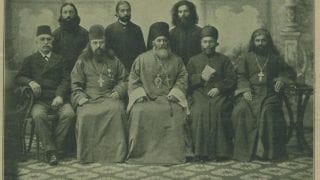
Mar Jonah and the Assyrian delegation to St. Petersburg in 1898:
http://azbukivedi-istoria.ru/publ/prochee/prisoedinenie_siro_khaldejskikh_nestorian_k_pravoslavnoj_cerkvi/5-1-0-90
Mar (Bishop) Elia (Abraham, Avraham, Awraham, Oraham) was born to a Nestorian Assyrian family in the village of Armutagash in the Urmia province (Persian Azerbaijan) of Persia in 1858 (some sources claim 1856).[1]No author given* The episcopate in the Nestorian church was hereditary, passed down from uncle to nephew, those eligible proclaimed ‘Natar Kursi’ (‘Nazarites’) from birth.[2]Brief biography of Mar Elia from Igumen Stefan (Sado), St Petersburg Theological Academy (e-mail) Father Igumen Stefan, of Assyrian ancestry himself, is an authority on the Russian Ecclesiastical … Continue reading “There is always kept up in the family a succcession of youths, who have never eaten meat and must not marry … They are supported by the Patriarchal revenues, which consist of the profits of lands and offerings in the nature of tithes. It is from these youths that the Catholicos (Patriarch) selects his successor, who is thus, from an early age, trained as Patriarch-Designate … the succession of bishops is managed much in the same way …” Mar Elia was born into a family of the hereditary episcopate, and named as ‘Natar Kursi’ himself.[3]Hoffman, The Very Reverend E.A., D.D., LL.D., Dean of the General Theological Seminary. “The Assyrian Church”. The Church Eclectic, an Anglo-Catholic Monthly of Church Literature with Notes and … Continue reading His family had included some twenty bishops (another source claims twelve).[4]Az Buki Vedi One of his uncles was Mar Gabriel of Ardishai (in the Urmia district), consecrated as a bishop by the Assyrian Patriarch Mar Shimun XVIII Rubil in 1872. In 1875, Mar Gabriel converted to Orthodoxy, and was accepted as a Bishop, with his title ‘of Ardishai.'[5]http://epecu.net/sura
Mar Gabriel was brought to Orthodoxy “through the diligence of Archbishop Sophonia (Stefan Vasilievich Sokolsky, 1799-1877) of Tashkent and Turkestan.” [6] ibid. While an Archimandrite, Archbishop Sophonia had been sent to Erivan by the Holy Synod to communicate with “Nestorians living in the province who desired” to join themselves to the Orthodox Church, and stayed there from 1861 to 1863. Archbishop Sophonia, a talented linguist, wrote extensively on the Assyrian church, as well as the Armenian and Jacobite churches. [7]Wikipedia Mar Gabriel “during his trip to Kurdistan from Persia, was brutally murdered on the Persian-Turkish border, and with him were killed 14 people who formed his retinue,” in 1896.[8]op. cit. 4
The future Mar Elia was graduated from the American Mission School in Urmia.[9]op. cit. 2 The American Mission in Urmia was founded by the Presbyterian Minister Justin Perkins, “the first citizen of the United States to reside in Iran [Persia], and he became known for his work among the people there as an ‘apostle to Persia.’” [10]Wikipedia Perkins was sent to Persia as a missionary by the American Board of Commissioners for Foreign Missions, assigned as a missionary to “the remaining members of the Assyrian Church of the East [Nestorians] in northwestern Persia.” [11]Wikipedia Founded by Congregationalists in 1810, it also accepted missionaries from other Protestant denominations, most notably, several Presbyterian and Reformed denominations. The ABCFM also sent promising students to study in the United States. [12]Encyclopædia Iranica When the Russian Ecclesiastical Mission in Urmia began in Persia, many Assyrians had left the Assyrian Church of the East for Protestantism. The American Mission School did accept those not converted to Protestantism, and part of the “the flock” of the American Mission later “easily” converted to Orthodoxy. The future Mar Elia learned English at the American Mission School. [13]http://www.atranews.com/religion/sado/sado.htm
Mar Elia was also sent to the United States to study, at the General Theological Seminary. [14] op. cit. 2 The arrangements for his study in the U.S. are not known, but as this was the primary seminary of the Protestant Episcopal Church in the U.S., it is doubtful that it was arranged by the ABCFM. [15]http://www.iranchamber.com/religions_articles_american_presbyterian_missionaries_zirinsky.pdf The Church of England also operated a mission in Urmia, the Archbishop of Canterbury’s Assyrian Mission, which “ostentatiously distanced itself from other missionary enterprises.” [16]Wikipedia The Archbishop of Canterbury’s Mission did not seek to convert members of the Assyrian Church of the East, but deemed it a “sister church,” acting as representatives of the “Anglo-Catholic,” or “High Church” segment of the Church of England. This orientation was obviously at odds with that of the American Mission. It was based on the “Branch Theory of Christianity,” formulated by Sir William Palmer, an Anglican theologian, in his work, “Treatise on the Church of Christ” (1838), in vogue in Anglican High Church circles at the time. The Archbishop of Canterbury’s Assyrian Mission sought to educate the Nestorians, convince them to renounce Nestorian errors, and enter into communion with them as a sister church, thereby ‘illustrating’ the Branch Theory, which the Roman Catholics and Orthodox would then supposedly be forced to accept. [17]Woerl, Michael
Mar Elia began his studies at the General Theological Seminary in New York City in May, 1894, graduating in 1896. [18] Mary Robinson, Reference Librarian at the Christoph Keller Jr. Library, General Theological Seminary, New York. E-mail Trustees minutes, and the student magazine, ‘The Seminarian,’ make reference to him as a “special student” who was a “Deacon from Oroomiah” (Urmia).[19]“Annual Catalogue of the Union Theological Seminary, N.Y., N.Y.” 1902-1903 pp. 17, 20 Google .pdf file “Students may be received to a partial course, and are then termed Special Students,” who had to be “college graduates or pass the normally required entrance examinations,” in English.[20]http://www.gts.edu/about-gts/our-heritage/35-about-us/general-content9/1030-gts-detailed-history The General Theological Seminary had been founded in 1817, and became “a leading center of theological education in the Anglican Communion,” and exists to this day.[21]Assyrian Information Management In 1888, the students of the Seminary donated the sum of 300 Pounds Sterling to the Archbishop of Canterbury’s Assyrian Mission, a sum equivalent to $20,000 today. [22]DaveManuel.com Mar Elia spoke the Syrian [Assyrian], Persian, Turkish, Hebrew and English languages.[23]LikeForex.com, [24]op. cit. 4, [25]op. cit. 5
One source dates Mar Elia’s ordination to Deacon in 1896 [26]op. cit. 4 ; the comments in the General Theological Seminary’s student magazine, that he was a “Deacon from Oromiah,” certainly place it in 1894 or before. Another source states his ordination to the priesthood in 1896, stating, “a priest since 1896 (Archdeacon)” [“Священник с 1896 г. (Архидьякон)”]. Other sources state he was “subsequently” tonsured as a monk, and elevated to Archimandrite, but give no date. [27]op. cit. 1
A large group of Nestorians converted to Orthodoxy in 1898, led by their bishop, Mar Jonah (Yonan in Assyrian) of Supurgansk. [28]http://books.google.com/books?%201898 from: The Eastern Churches Trilogy by Adrian Fortescue, GorgiasPress.com There had been earlier conversions other than that of Mar Gabriel and the Assyrians in Erivan noted above. “In 1827, a number of Nestorian families fled to Russian territory in Erivan and joined the Orthodox Church.” [29]op. cit. 4 Mar Jonah had journeyed to St. Petersburg in 1882 to discuss the conversion of his flock, and by 1896, there were 460,000 Assyrians, in Urmia and Kurdistan, who “look forward to reunion with Orthodoxy.” Services to receive Mar Jonah and his clergy in the Orthodox Church were held on the Feast of the Annunciation at the St. Alexander Nevsky Lavra in St. Petersburg with Metropolitan Pallady (Pavel Ivanovich Pisarev-Raev, 20 Jun 1875-05 Dec 1898) of Moscow officiating. [30]Wikipedia
On the morning of the Annunciation in 1898, when Bishop John (Ivan Alexandrovich Kratirov, 1839-1909, later Bishop of Saratov & Tsaritsin) of Narva, Vicar of the St. Petersburg Diocese, arrived at the Holy Trinity Cathedral in the St. Alexander Nevsky Lavra to begin the service to receive the Mar Jonah and his clergy into the Orthodox Church. Mar Jonah, Archimandite Elia (the future Mar Elia), the priests George and Sergei, and the Deacon Jacob Bahabanov were already in the church, in Orthodox clerical dress. The Cathedral was filled to capacity, and a large crowd had gathered outside, “excited … to take a look at their new brothers in the faith.” The Royal Doors were opened, and Metropolitan Pallady and his Vicars, came out surrounded by clergy. Metropolitan Pallady approached Mar Jonah, and asked him, “Do you renounce the errors of your forebears, and the errors of the Nestorian faith? Do you wish to unite with the Orthodox Catholic Faith?” Mar Jonah answered both questions in the affirmative, and Metropolitan Pallady listened to all the renunciations, and lifting his omophor exclaimed, “Enter the Orthodox Catholic Church!” After the Gospel reading, Bishop Jonah placed a mitre on the head of Archimandrite Elia, and during the Great Entrance, “the new Orthodox Bishop blessed the faithful with the dikiri-trikiri.” After the Liturgy, a festive meal was served at the Monastery; before the meal, V.K. Sabler, Procurator of the Holy Synod, read aloud the remarks of Tsar Nicholas II, welcoming the newly received Assyrians into the Orthodox Church. [31]Wikipedia Professor Vasily Bolotov of the St. Petersburg Theological Academy and “authority on the Eastern church,” had determined the manner in which the Assyrians were to be received into the Orthodox Church-renunciation of heresy by repentance, confession of faith, vesting, and acceptance of the ordinations of the clergy, as well as recognizing the Assyrian’s baptisms and chrismations. [32] op. cit. 4 Mar Jonah was given the title ‘of Supurgansk and Urmia.’ [33]belolikovi.narod.ru
The day after Mar Jonah and his clergy were accepted into the Orthodox Church (26 Mar 1858), the Holy Synod of the Russian Orthodx Church, with Resolution #1121, instituted the Russian Ecclesiastical Mission in Urmia. The purpose of the Mission was to aid the flock of Mar Jonah in Urmia in the acceptance of and transition to Orthodoxy, and provide for their education in the Faith, for the establishment of Orthodox worship, and “any other necessary steps in the matter.” Many other difficulties were faced … the Western Missions in Urmia were rich, and well established. “The age-old sympathy for Russia, and the desire for Russia’s patronage, initially blocked western influence;” however, the expectations of the newly Orthodox flock in Urmia were high. These included their protection by Russia, and the bettering of their position within the Muslim Persian state. Educating the Assyrians in the Orthodox spirit would have to teach them that such high expectations could not be achieved instantly. Eventually the Mission accomplished a great deal, but there were missteps early on; some clergy assigned to the Mission, proving themselves not up to the task, variously faced dismissal, defrocking, or simply quit.[34]op. cit. 13
After his reception into the Orthodox Church, Mar Elia remained in Russia until 1903, auditing courses at the St. Petersburg and Kiev Theological Academies in 1898 and 1899 respectively. In 1899, a collection of Pushkin’s writings were published in a book commemorating the 100th anniversary of his birth (Пушкинский сборник – в память столетия дня рождения поэта, A.S. Suvorin). This book included four pages of facsimiles of Pushkin poems translated into Assyrian from a manuscript of the future Mar Elia. The heading on those pages read, “Pushkin in the Chaldean Language.” [35]op. cit. 2 On 25 Jan 1904, Archimandrite Elia was consecrated to the episcopate as Bishop of Tergawar, Vicar of Mar Jonah. The consecration was presided over by Metropolitan Antony (Alexander Vasilievich Vadkovsky, 1846-1912) of St. Petersburg. The consecration took place in the Holy Trinity Cathedral of the St. Alexander Nevsky Lavra in St. Petersburg. Returning to Urmia, the newly consecrated Mar Elia assisted Mar Jonah with the administration of the parishes of the Supurgansk-Urmia Diocese, and the Holy Synod assigned him primarily to oversee the parishes in the southern part of the diocese. Mar Jonah reposed in the Lord in 1910. At that time, Mar Elia began to administer the entire diocese, and in 1911 was elevated to ruling bishop, with the title ‘of Supurgansk and Urmia.'[36]Wikipedia
The years 1904 to 1910 were difficult for the Orthodox in Urmia. Russia’s defeat by Japan, and the unrest in Russia that followed, caused a loss of respect for Russian power, and the Muslims took advantage of this situation-persecution by the Khans in Persia, as well as “the looting of villages, the desecration of churches, murder, rape, and kidnapping of Christian girls” by Kurds. Things improved gradually in 1911 when Russian troops were stationed in Azerbaijan, through 1914. There were also various intrigues and hostilities perpetrated by the foreign missions in Urmia (American, British and French Roman Catholics.) There were even times that the Ecclesiastical Mission in Urmia and the Assyrian bishops – Mar Jonah and Mar Elia – were at odds with each other, sending opposing complaints to the Holy Synod in St Petersburg. The Ecclesiastical Mission in Urmia did accomplish the construction of forty churches in the province by 1914. Assyrian priests were employed by the Mission, a great number of services and other Orthodox literature was translated, and from 1905 to 1906, and again from 1911 to 1914, the periodical ‘Orthodox Urmia’ was published in Assyrian and Russian, and schools and a library were founded.[37]op. cit. 13
World War I created havoc for the Orthodox in Urmia. Nestorian Assyrians in the Ottoman Empire, whose situation had been somewhat alleviated by the efforts of Urmia’s Orthodox Mission, were attacked and persecuted by Kurds in the Ottoman Empire across the border from Urmia in September of 1914 (war between Russia and the Ottoman Empire was not announced until mid October 1914), causing a great number of refugees to flee to Urmia. Cossack units and Assyrians prevented the Kurds from entering Persia, but an attack on Persia by Ottoman troops in late December 1915 resulted in a secret order for Russian troops to evacuate Urmia and make their way to Russian territory. The retreating Russians, accompanied by Mission staff, were followed by several thousands of Orthodox Assyrians, ill-eqiuipped for travel, and suffering much along the route, leaving “thousands of Christians in Urmia under the threat of complete destruction by fanatical Muslims.”[38]op. cit. 13
“In October 1914, the Ottoman Empire began deporting and massacring Assyrians and Armenians in Van. After attacking Russian cities, and declaring war on Britain and France, the Empire declared a holy war on Christians.” [39]Wikipedia 1915 brought that holy war, the Fatwa of the Sheikh-ul-Islam (highest Islamic authority in the Ottoman Empire, confirmed by the Sultan) to Urmia. [40]history.com [41] text of the Fatwa against the “Infidels” can be found here, Entire Assyrian villages were destroyed, with their inhabitants, in Urmia. Assyrians were ordered to renounce Christ, or die, and their were cases of martyrdom. In Urmia, “Godless invaders gathered groups of Christians, who were unarmed men, women, and children, and drove them into wells. These wells, filled with humanity, were guarded, while other Kurds dashed to the already destroyed houses, produced kerosene oil and poured it into the wells. On January 4th no less than fifteen wells had been filled at Jandarli, near Urmia, and, simultaneously, they were set on fire. Merciful Father! I can still hear the shrieks of the victims. But their tormentors watched the work with serene satisfaction … 12,000 Christians became victims of this awful cruelty.”[42]op. cit. 13
Inside the city of Urmia, similar atrocities took place. Some 15,000 Assyrians took refuge within the walls of the American Mission in Urmia. Starvation and disease were rampant, causing many to perish.[43]http://www.atour.com/history/1900/20110130a.htm Seventy Turkish troops entered the Mission, hanged the Orthodox Bishop Mar Elia, and four Orthodox clergymen …Shortly before, sixty refugees had been dragged from the French Mission and executed …” Mar Elia was not hanged, as reported, but had been tortured. He had to be ransomed from the Muslims for “a huge” price.[44]http://www.atour.com/history/periodicals/20120210a.htm Later in 1915, Mar Elia travelled to Moscow, where he lived in a monastery. In 1916, he was bestowed with the Order of Saint Vladimir, third degree. Mar Elia returned to Urmia in March 1917. In December 1917-January 1918, he was sent to Tbilisi along with other delegates of the Assyrian people, to appeal to representatives of the Entente (Western alliance in WWI) in the Caucasus to secure aid for the Christians left in Urmia after the withdrawal of Russian troops. [45]op. cit. 43
After returning to Urmia, in late 1918, due to yet more persecution at the hands of Muslims, over 100,000 Christians fled Urmia towards Iraq, where there were British forces. Many were killed or perished from diesase and starvation on the road. [46]Wikipedia Mar Elia accompanied the refugees through Hamadan, to Tabriz, in Persia. He returned to Urmia in 1920. [47]op. cit. 2 In 1921, unable to communicate with Patriarch Tikhon in Moscow, Mar Elia contacted the Synod of the Russian Orthodox Church Outside of Russia, and joined his diocese to ROCOR.[48]op. cit. 1 Known as a great preacher, Mar Elia spent the remainder of his earthly life with his flock, and reposed in the Lord on 01 Nov 1928 (other sources claim December 1928) in the city of Urmia. He was buried in the Mat Mariam Orthodox church in Urmia. [49]op.cit. 4 Memory Eternal!
“Oraham’s Dictionary of the Stabilized and Enriched Assyrian Language and English” was authored typeset, and published by a relative of Mar Elia, Dr. Alexander Joseph Oraham. Born in Armutagash in February 1898, he emigrated to the US in 1913. After studying medicine, he established what became a successful medical practice. In 1941, Dr. Oraham started a printing/publishing company, “known as the greatest Syriac printing establishment in the world.” His Consolidated Press (Assyrian Press of America), published the dictionary in 1943.[50]http://www.atour.com/people/20010702c.htm
Afternote
There is a thriving Orthodox Assyrian community, and monastery, in Tbilisi, Georgia, in the jurisdiction of the Georgian Orthodox Church. It is directed by Schema-Archimandrite Seraphim (Bit-haribi). Orthodox Assyrian parishes exist in Iraq, Syria, Lebanon, Russia, Armenia, and Ukraine. Igumen Stefan (Sado), of Assyrian descent, professor at the St Petersburg Theological Academy, is an authority on the Russian Ecclesiastical Mission in Urmia. The Ukrainian Orthodox Church (MP) has assigned Bishop Iona (Cherepanov) of Obukhovsk as liaison with the Orthodox Assyrians in Ukraine. Orthodox Assyrian priests serve in the Patriarchates of Constantinople, Antioch, and Moscow in various parts of the world. A listing of Orthodox Assyrian priests worldwide can be found at: http://epecu.net/sura
Special thanks to Father Igumen Stefan (Sado), and Mary Robinson, Reference Librarian at the Christoph Keller Jr. Library, General Theological Seminary, New York. To Father Vladimir Boikov and Father Deacon Andrei Psarev, for taking me where Google Translate does not go. No author given”-on the remainder of the references, if no author is mentioned, no author was named on the reference.
References
| ↵1 | No author given* |
|---|---|
| ↵2 | Brief biography of Mar Elia from Igumen Stefan (Sado), St Petersburg Theological Academy (e-mail) Father Igumen Stefan, of Assyrian ancestry himself, is an authority on the Russian Ecclesiastical Mission in Urmia |
| ↵3 | Hoffman, The Very Reverend E.A., D.D., LL.D., Dean of the General Theological Seminary. “The Assyrian Church”. The Church Eclectic, an Anglo-Catholic Monthly of Church Literature with Notes and Summaries, Volume, 1896-1897, Milwaukee, p. 315 online: as Mar Elia graduated from the General Theological Seminary in 1896, it seems a possibility that he may have contributed information for the article … |
| ↵4 | Az Buki Vedi |
| ↵5 | http://epecu.net/sura |
| ↵6 | ibid. |
| ↵7 | Wikipedia |
| ↵8 | op. cit. 4 |
| ↵9 | op. cit. 2 |
| ↵10 | Wikipedia |
| ↵11 | Wikipedia |
| ↵12 | Encyclopædia Iranica |
| ↵13 | http://www.atranews.com/religion/sado/sado.htm |
| ↵14 | op. cit. 2 |
| ↵15 | http://www.iranchamber.com/religions_articles_american_presbyterian_missionaries_zirinsky.pdf |
| ↵16 | Wikipedia |
| ↵17 | Woerl, Michael |
| ↵18 | Mary Robinson, Reference Librarian at the Christoph Keller Jr. Library, General Theological Seminary, New York. E-mail |
| ↵19 | “Annual Catalogue of the Union Theological Seminary, N.Y., N.Y.” 1902-1903 pp. 17, 20 Google .pdf file |
| ↵20 | http://www.gts.edu/about-gts/our-heritage/35-about-us/general-content9/1030-gts-detailed-history |
| ↵21 | Assyrian Information Management |
| ↵22 | DaveManuel.com |
| ↵23 | LikeForex.com |
| ↵24 | op. cit. 4 |
| ↵25 | op. cit. 5 |
| ↵26 | op. cit. 4 |
| ↵27 | op. cit. 1 |
| ↵28 | http://books.google.com/books?%201898 from: The Eastern Churches Trilogy by Adrian Fortescue, GorgiasPress.com |
| ↵29 | op. cit. 4 |
| ↵30 | Wikipedia |
| ↵31 | Wikipedia |
| ↵32 | op. cit. 4 |
| ↵33 | belolikovi.narod.ru |
| ↵34 | op. cit. 13 |
| ↵35 | op. cit. 2 |
| ↵36 | Wikipedia |
| ↵37 | op. cit. 13 |
| ↵38 | op. cit. 13 |
| ↵39 | Wikipedia |
| ↵40 | history.com |
| ↵41 | text of the Fatwa against the “Infidels” can be found here |
| ↵42 | op. cit. 13 |
| ↵43 | http://www.atour.com/history/1900/20110130a.htm |
| ↵44 | http://www.atour.com/history/periodicals/20120210a.htm |
| ↵45 | op. cit. 43 |
| ↵46 | Wikipedia |
| ↵47 | op. cit. 2 |
| ↵48 | op. cit. 1 |
| ↵49 | op.cit. 4 |
| ↵50 | http://www.atour.com/people/20010702c.htm |

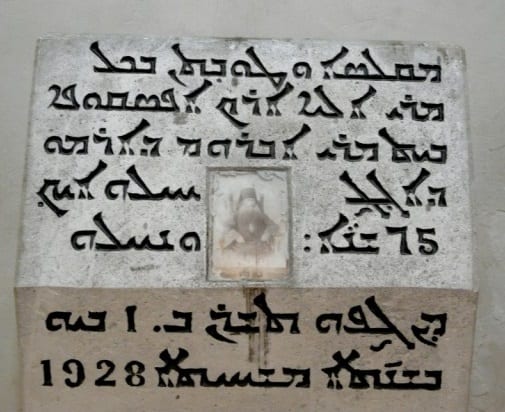
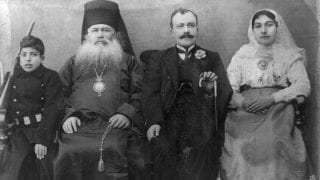
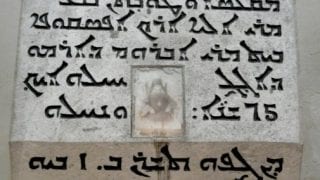







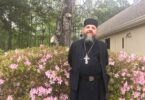

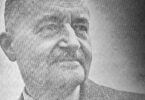
Thanks fo this article
Wonderful article! Here in San Jose (in the Silicon Valley, San Francisco Bay Area, California) exists a large Assyrian community, and there is an Assyrian Greek Orthodox priest who serves in Oakland. God-willing, the Orthodox faith will spread to the Assyrians here in the Bay Area.
Wonderful! Thank you!
Great article. I have the original pictures of my ancestors
I do not know if you would know this, but what rite did Mar Elia or Mar Yonan celebrate? Did they celebrate the East Syriac rite typically associated with the ACOE, or did they use the typical Byzantine liturgy?